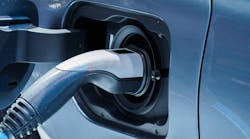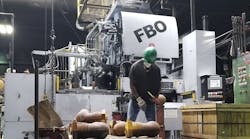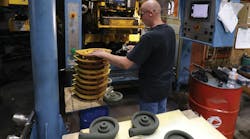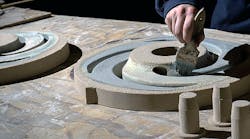In a twist on a frequently told story, a mechanical engineer who had gained some expertise in 3D-printing sand molds decided to expand into metalcasting – with quick customer service as the differentiator for his start-up business. Now, the Printed Casting package that Ville Moilanen has made his business, Hetitec Oy, one of the most modern and fastest foundries in Europe. It uses additive manufacturing, process simulation, melting, and casting to produce parts in iron and steel, and aluminum alloys, promising finished results within one week
In 2008, Ville Moilanen joined voxeljet technology GmbH in Augsburg, Germany, where among other accomplishments he supervised establishment of voxeljet’s on-demand center for printed sand cores and molds and was responsible for sales in the Scandinavian market.
Today, voxeljet AG is the developer of high-speed, large-format 3D printers and on-demand 3D-printed parts to industrial and commercial customers.
Working with customers, Moilanen discovered that the average delivery time for castings in Finland was over three months, and this despite the fact that there are many large, Finnish businesses in mechanical engineering, energy supply, and shipbuilding, among others – industries that typically have a high demand for castings, especially for prototype parts.
The reason for long lead times is that most Finnish foundries are engaged in series production with standard molding methods. Another important factor is a shortage of skilled foundry engineers, such that in many foundries the operators are so occupied with series production that they do not have the time to work on small- to medium-sized orders.
In 2012 Moilanen decided to move back to Finland to start his metalcasting business in Pirkanmaa, close to the city of Tampere. In 2013, he began offering on-demand 3D printing of furan sand molds and cores, using a voxeljet VX1000 printer.
This was the Hetitec business model until 2018, when Moilanen decided to scale up and expand, and transforming the business into a highly specialized foundry. His novel idea was (and is) not to be a foundry with 3D-printing capability, but a foundry centered around the 3D printer. The specific objective is to speed up the delivery of castings.
The first foundry equipment was installed at Hetitec in early 2020, including four melting furnaces for various alloys. Hetitec can melt steel (including duplex grades), gray iron, ductile iron (including ADI, SiMo, etc.), as well as some aluminum alloys.
In order to avoid casting defects and keep the rejection rate as low as possible Hetitec invested in CAD software for moldmaking and casting simulation.
Finally, in addition to the VX1000, Hetitec supplemented its additive manufacturing production with a voxeljet VX2000 in 2021. The large-format 3D printing system has a build volume of 2x1x1 meters – well-suited for producing large molds individually or a variety of smaller components. The printer recently underwent a process update, making it nearly 40% more productive.
"If it were up to our customers, they would prefer to have the castings yesterday, a service we unfortunately cannot offer as of yet,” according to Moilanen, who is Hetitec’s managing director. “But we can easily print one job box in less than a single day, which makes the VX2000 the most productive 3D printer in the whole of Finland.
“Given our equipment, we are able to produce casting sizes ranging from 1-600 kg within just a few days, with a unique portfolio in terms of material diversity.”
There is more to the service. For machining and quality assurance Hetitec has co-op arrangements with nearby companies, so that freshly cast parts can be directly machined and inspected before shipment. This workflow lets Hetitec deliver finished parts within just a week. “This makes us the fastest foundry in the whole of Scandinavia,” Moilanen claimed, enthusiastically.
Regional casting buyers in sectors like shipbuilding, automotive, energy, forest machinery, and offshore oil-and-gas stand to benefit from Hetitec’s services, especially the Printed Casting offering, along with the selection of specialty alloys. Manufacturing trends like lightweight design; design initiatives, like electromobility; and the reliability and efficiency of digitizing tooling and pattern inventories – all are fulfilled by 3D printing. Using scanning capability, old tool inventories are converted CAD files and can be retrieved from a digital warehouse at any time, and then printed and cast as needed, saving production time as well as storage costs.
"Adoption of this approach is still not widespread in Finland," Moilanen explained. "In some cases, only a good 10% of all stored spare part patterns and molds for instance are regularly retrieved and used in Finland. The remaining 90% more or less just take up storage space.”
The digitization of tool inventories and 3D printing offer considerable advantages, especially in regard to spare parts production. With its creative business model as well as its fast-response time, Hetitec targets to close this knowledge gap and expand its business and know-how across Europe.
If potential casting buyers need proof, Hetitec has another successful story to tell: Due to an engine defect, an icebreaker was stuck near the coast of Canada. The usual delivery time for the required component was around five months, which presented a considerable cost for the customer. Quick-availability of a spare part essential to repair the ship.
The shipping line sent a 2D design of the part to Hetitec. Within an hour, the 2D drawing was transformed into a 3D-CAD file. Actual part production started with 3D printing the sand molds on Monday, and by Friday the finish-machined casting was on its way to Canada.
In Canada, the part was loaded onto a helicopter and brought the part to the ship, which to save time had already steered towards its destination using just one engine.
With the addition of the new VX2000 to its additive manufacturing line, Hetitec is pursuing a successive expansion of its business in Europe, an expansion that will be fast if the business’s record is any indicator.









